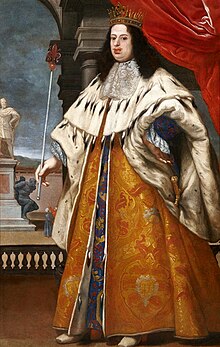| Cosimo III | |||||
|---|---|---|---|---|---|
 Cosimo in granducal robes with Tuscan regalia by Baldassare Franceschini, 1676–77 | |||||
| Grand Duke of Tuscany | |||||
| Reign | 23 May 1670 – 31 October 1723 | ||||
| Predecessor | Ferdinando II | ||||
| Successor | Gian Gastone I | ||||
| Born | 14 August 1642 Pitti Palace, Florence, Grand Duchy of Tuscany | ||||
| Died | 31 October 1723 (aged 81) Pitti Palace, Florence, Grand Duchy of Tuscany | ||||
| Burial | Basilica of San Lorenzo, Tuscany | ||||
| Spouse | Marguerite Louise d'Orléans | ||||
| Issue Detail | |||||
| |||||
| House | Medici | ||||
| Father | Ferdinando II de' Medici | ||||
| Mother | Vittoria Della Rovere | ||||
| Religion | Catholicism | ||||
Cosimo III de' Medici (14 August 1642 – 31 October 1723[1]) was Grand Duke of Tuscany from 1670 until his death in 1723, the sixth and penultimate from the House of Medici. He reigned from 1670 to 1723, and was the elder son of Grand Duke Ferdinando II. Cosimo's 53-year-long reign, the longest in Tuscan history, was marked by a series of laws that regulated prostitution and May celebrations.[clarification needed] His reign also witnessed Tuscany's deterioration to previously unknown economic lows.
Cosimo III married Marguerite Louise d'Orléans, a cousin of Louis XIV. The marriage was solemnized by proxy in the King's Chapel at the Louvre, on 17 April 1661. It proved to be a very difficult marriage. Marguerite eventually abandoned Tuscany for the Convent of Montmartre. Together, they had three children: Ferdinando in 1663, Anna Maria Luisa, Electress Palatine, in 1667, and Gian Gastone I the last Medicean ruler of Tuscany, in 1671.
In later life, Cosimo III attempted to have his daughter recognised as the universal heiress of Tuscany, after his sons (who did not look like they would produce heirs), but Charles VI, Holy Roman Emperor, would not allow it because Tuscany was an imperial fief, and he felt he alone could alter the Tuscan laws of succession. In 1723, when Cosimo died, he was succeeded by his younger son.[2] All Cosimo III's efforts to salvage the throne for his family foundered, and in 1737, upon the death of Gian Gastone, Tuscany passed to the House of Lorraine.
- ^ Guarini, Elena Fasano (1984). "COSIMO III de' Medici, granduca di Toscana". Dizionario Biografico degli Italiani. Vol. 30.
- ^ Hale, pp. 185–186.